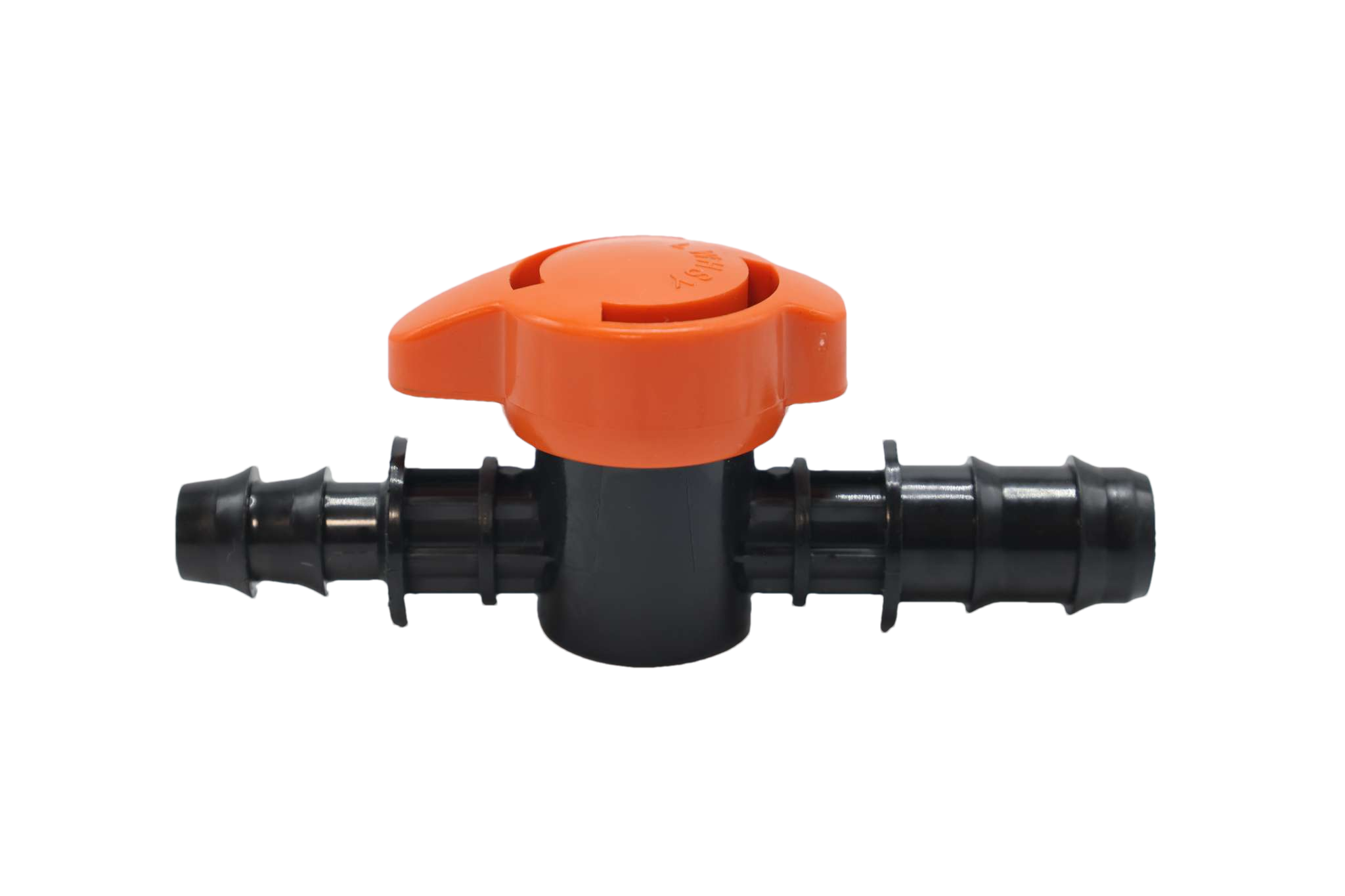What Is a Mini Bypass Valve and How It Functions in Drip Irrigation Systems
The mini bypass valve serves as a small but important part of drip irrigation systems, redirecting extra water back to the main reservoir. Traditional valves tend to block flow completely, while this one keeps things running smoothly at just the right pressure level. When system pressure goes above 1.2 to 1.8 bar, the valve opens on its own. According to MWIrrigation's findings from 2025. The design fits nicely into pipes between 10 and 16 mm in diameter without messing up how emitters are spaced apart. This makes it particularly useful in greenhouses where tight spaces make regular bypass options difficult to install. Greenhouse growers who incorporate these types of micro-irrigation parts report saving anywhere from half to nearly all their water usage versus traditional field farming methods. Nature magazine published similar results in their 2025 study.
Role in Pressure Regulation and Flow Control for Stable Water Delivery
Mini bypass valves mitigate two critical drip system failures:
| Pressure Challenge | Traditional System Risk | Mini Bypass Solution |
|---|---|---|
| Pump surges (>2 bar) | Pipe burst (17% failure rate) | Diverts 30–40% flow instantly |
| Emitter clogging | 22% flow reduction | Maintains 0.8–1.5 bar baseline pressure |
| Temperature shifts | ±15% flow variance | Compensates through dynamic bypass aperture |
By maintaining pressure within a 0.3 bar variance window, these valves reduce crop hydration disparities to <8% across 100-meter greenhouse rows (MWIrrigation 2025).
Advantages Over Traditional Bypass Valves in Precision Agriculture
Three key innovations make mini bypass valves superior for greenhouse environments:
- 65% smaller footprint enables installation at 2x density compared to standard bypass hardware
- Pressure-sensitive polymer diaphragms respond 0.8 seconds faster to flow changes
- Self-flushing mechanism reduces particulate buildup by 42% in saline water conditions
Leading agricultural research trials demonstrate these valves reduce water waste in drip systems by 19% while increasing strawberry yields by 8.7 kg/m² annually through consistent root-zone hydration (Nature 2025). Their compatibility with IoT soil sensors allows real-time flow adjustments matching evapotranspiration rates, addressing humidity-driven water loss common in greenhouse climates.
Key Applications of Mini Bypass Valves in Greenhouse Water Management
Precision Water Distribution in Drip Irrigation Setups Using Mini Bypass Valves
The mini bypass valves help keep the flow rates pretty consistent within about 3% across drip irrigation systems. They work by moving extra pressure from the main pipes over to those smaller lateral lines when needed. What does this mean for growers? No more annoying dry patches at the end of greenhouse rows, plus better moisture throughout all the soil. Some tests ran last year in Shandong showed these valves cut down on wasted water by around 22 percent compared to older models with fixed openings. That's a big deal for farmers trying to save resources without sacrificing crop quality.
Integration with Automated Irrigation Controls for Optimal Plant Hydration
Mini bypass valves act as pressure regulators for soil moisture sensors connected to weather responsive irrigation systems. These small but important components keep operating pressures steady between 0.2 and 0.35 MPa when pumps start up or shut down. This stability makes all the difference for accurate fertilizer application rates in irrigation systems. According to research from the University of Agriculture Nanjing published last year, farms that install these automated valves see an impressive drop in pressure surges – around 89% less than what happens with traditional manual setups. Farmers who've made the switch report fewer equipment failures and better crop yields as a result.
Strategic Placement to Mitigate Clogging Risks in Sensitive Drip Lines
Installation at every 15-meter interval in 16-mm diameter laterals prevents particle accumulation through controlled turbulence generation. This configuration reduced emitter clogging incidents by 76% in sand-heavy irrigation water applications, while maintaining 98% system uptime during 6-month growing cycles.
Case Study: Improved Crop Yield in Jinan Greenhouses with Mini Bypass Valve Technology
After installing mini bypass valves on around 8,000 drip lines in their 1.2 hectare greenhouse operation, farmers saw tomato yields jump by about 17%. These small but effective valves helped balance out water distribution across the terraced beds where elevation changes had previously caused problems. With these adjustments, electrical conductivity levels stayed consistently between 1.8 and 2.0 dS/m throughout the entire system. An added bonus was water savings too - growers used 31% less water for each kilogram of tomatoes produced compared to what they were using before making these improvements last season. This kind of efficiency makes a big difference when looking at long term costs and sustainability goals for agricultural operations.
Installation Best Practices for Mini Bypass Valves in Greenhouse Systems
Step-by-Step Guide to Connecting Mini Bypass Valves in Greenhouse Pipelines
Start the installation process by running water through all pipelines to clear out any dirt or particles that might block the valves later on. Make sure the valves are properly aligned according to those little arrow indicators on them before securing everything down with good quality compression fittings designed specifically for irrigation systems, which usually handle pressures between 15 and 60 pounds per square inch. When placing these valves along the pipeline, leave around five times the diameter of the pipe between each one to prevent water from getting too turbulent, something we've seen cause problems in many actual installations over time. Greenhouse operators working with half inch polyethylene tubing should give themselves extra space here too about three to four inches of straight pipe both before and after each valve will help stabilize the water flow much better in practice.
Compatibility with Common Pipe Materials and Diameter Sizes
Mini bypass valves function seamlessly with PVC, LDPE, and reinforced polyethylene pipes ranging from ½” to 1½” diameters. When retrofitting existing systems, match valve threads to pipe specifications:
- 3/4” NPT threads for standard greenhouse feeder lines
-
1” compression fittings for flexible drip tubing
Pressure test hybrid systems combining metal and polymer pipes at 1.5x operating pressure for 30 minutes to verify compatibility.
Ensuring Leak-Free Joints and Long-Term System Integrity
Apply two layers of Teflon tape clockwise to male threads before connecting valves. For compression fittings, replace O-rings annually using ethylene propylene diene monomer (EPDM) seals resistant to fertilizers and pH fluctuations. Quarterly inspections should verify:
- No mineral buildup on bypass ports
- Consistent flow rates across all zones (±5% variance)
- Zero moisture at connection points
Greenhouses implementing these practices report 92% reduction in leak-related water waste compared to traditional installation methods.
Water Conservation and Sustainability Benefits of Mini Bypass Valves
Quantifying Water Savings: Trial Data from Jinan Hongshengyuan Water Saving Irrigation Co., Ltd.
A major irrigation company ran field tests showing that when they added mini bypass valves to greenhouse systems, water consumption dropped around 28% compared to regular setups. What makes these valves work so well is their ability to keep water flowing steadily despite pressure changes, which means plants get just the right amount of moisture where it matters most at the roots. Looking at the results from these trials, there was about a 15% boost in how efficiently crops grew because less water went to waste and watering schedules became much better balanced. This kind of improvement really supports efforts toward making big scale farming more sustainable without sacrificing productivity.
Reducing System Downtime Through Reliable Bypass Mechanisms
Mini bypass valves cut maintenance-related downtime by 40% through their self-cleaning design and corrosion-resistant materials. Unlike traditional valves prone to clogging, their compact structure diverts debris without interrupting water flow. This reliability is critical for automated irrigation systems, where unplanned maintenance can disrupt hydration schedules and compromise crop health.
Long-Term Environmental and Economic Impact of Drip Irrigation Mini Valves
Greenhouses that installed mini bypass valves saw some impressive results over five years in their operations. Water bills dropped by around 22%, and there was a significant 35% cutback on fertilizer runoff into surrounding areas. The way these valves regulate water flow so precisely helps growers meet those tricky water conservation regulations without hassle. Plus, since they're built tough from stainless steel components, most facilities find they don't need replacing as often which saves money long term. When looking at actual numbers, each thousand acres equipped with these systems conserves roughly 12 million gallons per year. To put that into perspective, that's enough water to supply about ninety average sized homes throughout an entire year.
FAQ Section
What is the primary function of a mini bypass valve?
A mini bypass valve redirects extra water back to the main reservoir in drip irrigation systems, maintaining optimal pressure levels to avoid system failures.
How do mini bypass valves benefit greenhouse agriculture?
They maintain consistent pressure and flow rates, reduce water waste, mitigate emitter clogging, and are compatible with automated irrigation systems for efficient resource management.
Are mini bypass valves compatible with all types of pipes?
Yes, mini bypass valves work with PVC, LDPE, and reinforced polyethylene pipes ranging from ½” to 1½” in diameter.
What are the installation best practices for mini bypass valves?
Ensure proper alignment, use quality compression fittings, and leave sufficient space between valves to prevent turbulence. Regular inspections for leaks and maintaining a clean system are also recommended.
Table of Contents
- What Is a Mini Bypass Valve and How It Functions in Drip Irrigation Systems
- Role in Pressure Regulation and Flow Control for Stable Water Delivery
- Advantages Over Traditional Bypass Valves in Precision Agriculture
-
Key Applications of Mini Bypass Valves in Greenhouse Water Management
- Precision Water Distribution in Drip Irrigation Setups Using Mini Bypass Valves
- Integration with Automated Irrigation Controls for Optimal Plant Hydration
- Strategic Placement to Mitigate Clogging Risks in Sensitive Drip Lines
- Case Study: Improved Crop Yield in Jinan Greenhouses with Mini Bypass Valve Technology
- Installation Best Practices for Mini Bypass Valves in Greenhouse Systems
- Step-by-Step Guide to Connecting Mini Bypass Valves in Greenhouse Pipelines
- Compatibility with Common Pipe Materials and Diameter Sizes
- Ensuring Leak-Free Joints and Long-Term System Integrity
- Water Conservation and Sustainability Benefits of Mini Bypass Valves
- FAQ Section

